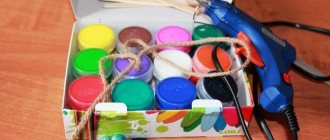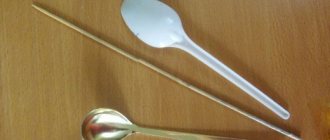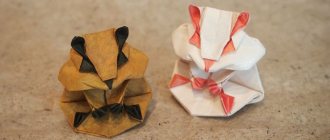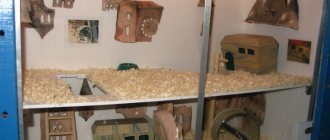Ekaterina Khlebushkina
Master class on making “Well and Crane” crafts from chopsticks
Participation in the competition “Vegetable Garden on the Window”
, inspired me to
make a well and a crane .
I really wanted to show the children of my middle group how people used to manage without running water to water their garden beds. The master class is intended for school-age children and parents, educators and additional education teachers.
Goal: Making a well and a crane from Chinese chopsticks .
Objectives: To develop imagination and the desire to do something unusual with your own hands.
Materials and tools:
— Chinese chopsticks (unlimited quantity)
.
— Basis for crafts .
— Wood glue (for wood)
.
— Water container (inserted into the well )
.
Loosening the soil
This is the very first thing that comes to mind. Thin, smooth sticks are convenient for gently loosening the soil in beds with young and very tender plantings. For example, they can be used in boxes with seedlings, flower pots in the country, in carrot shoots, etc.
Where you can’t swing a hoe, it’s convenient to reach with Chinese wooden chopsticks. Sprouts and seedlings will remain unharmed.
Plant support
Growing seedlings sometimes need a little support. Shoots of cucumbers, young tomatoes, and growing peas cling well to wooden sticks.
There is no need to run around and look for something to quickly stick into the ground. You can take a ready-made sushi stick and tie the seedlings to it.
She will also help out and support homemade flowers in pots. Orchids will be glad to meet a fellow from the subtropics, even in such an unusual transformation.
Hot stand
There are many options, but they are all simple. The sticks can be tied, braided with thin twine, or placed on hot glue.
They must first be fastened in pairs with opposite ends to form even bars. Then you need to assemble a square or elongated hot stand from them. If desired, you can even get a small tray for the tea ceremony.
And if you fasten the sticks by their thin ends, you will get an exclusive stand in the shape of a fan or circle.
Weaving sticks
Take measurements from your canvas. If it is too large, then cut it so that the width and length can fit 3 sticks. After this, start weaving. Start from the middle, gradually moving to the edges of the work surface. There is nothing complicated here.
He prescribed magnets to patients and used them himself: how the chief physician of the 18th century treated
5 things that can be a source of unpleasant odor in the apartment
A friend made a heart out of succulents: her husband really liked the idea
You just need to tie one loop on each end of the chopstick. First, press it tightly to the fabric, and then bring the remaining strand behind the leading one. Repeat the same with the rest.
Important nuance! The twine must be twisted around the sticks in the same direction. Otherwise, it may come loose.
In addition, the knot must be made not only from the front, but also from the back.
When all the sticks are securely fixed, all you have to do is make a small loop on the canvas for hanging the picture on the wall.
Birdhouse
If you have accumulated a lot of sticks, you can while away the evenings by designing various crafts and assembling them according to the principle of a building set. Once upon a time, Soviet people were fond of crafts made from matches: using the principle of wooden log houses, they made souvenir houses, churches, wells, mills and much more.
Sushi sticks will make a wonderful house for starlings. Or you can simply use sticks for the perch to the finished traditional birdhouse. Feathered friends will settle in it and delight summer residents all summer, and at the same time help get rid of insects.
LiveInternetLiveInternet
One of my favorite moments in life is going to a Japanese restaurant.
I love Japanese dishes, but I don’t spoil myself often, so as not to get tired of the charm of the small culinary masterpieces of Asian cuisine. What do you need to visit a Japanese restaurant? Money, mood and ability to hold sticks.
I think of the three points, the question can only arise about how to hold chopsticks for sushi and rolls.
But first
A little history...
Chopsticks
(hashi) are a pair of small chopsticks, a traditional cutlery in East Asia.
The four countries where chopsticks are predominantly used are China, Japan, Korea and Vietnam. In Thailand, with the introduction of European cutlery into circulation in the 19th century by King Rama V, only noodles or soups are eaten with chopsticks
Hashi came to Japan from China in the 12th century and was made from bamboo. The current separate form of chopsticks appeared in Japan during the Asuka period (593 - 710). By this time, their use had not yet become widespread. It was believed that immortal gods and emperors eat with chopsticks. According to Chinese chronicles, at that time only the imperial court and the Japanese aristocracy used hashi , and commoners still ate with their hands. It was only by the Nara period that ordinary people also began to eat with chopsticks.
Since then, chopsticks for the Japanese are not only an everyday personal item (it is not customary to share them with others), but also a sacred symbol (the Japanese respectfully call them o-hashi)
. According to legend, they bring good luck and long life to the owner, so it is not surprising that Khasi are considered a good holiday gift. For example, hashi is presented to newlyweds, implying the desire to be as inseparable as a pair of sticks. They are given to a baby on the 100th day of his birth, when, during the “First Chopsticks” ceremony, adults give him the first taste of rice using chopsticks. They also make gift sets of chopsticks for the whole family.
There are many types of hashi sticks: for regular food, for culinary purposes, for cakes and desserts. In addition, there are hashi for the New Year, the tea ceremony, and for sweets. Modern khasis are made of bone, wood (bamboo, pine, cypress, plum, maple, black or purple sandalwood), and the material for them can also be silver, iron and aluminum. Recently, plastic has been used a lot. Occasionally there are sticks made of such exotic materials as ivory or deer antler, but this is rather an exception. Metal chopsticks are used primarily for cooking and not as cutlery.
In Japan, one of the advantages of chopsticks over European cutlery is that “you don’t have to scratch your teeth with the pieces of iron.” Therefore, even catering establishments do not serve practical and durable metal chopsticks. Instead, they use disposable warbashi , which are made from a single, relatively roughly processed piece of wood, sawn lengthwise a little short of the end - a sign that no one has used the chopsticks, so they need to be broken before use. By the way, now most restaurants serve waribashi sticks made of plastic. They are intended for one-time consumption and are served with the dish in a sterile, sealed paper envelope ( hashi bukuro ), which often turns out to be a real decoration and collectible. It can be painted with fancy designs, or it can contain a restaurant logo. This is much more hygienic than using reusable European cutlery.
There are many variations in shapes and sizes of reusable chopsticks ( nuribashi ), which sometimes represent a real work of art: they are painted, varnished, inlaid with mother-of-pearl and decorated with various patterns. , round or square in cross-section with a conical or pyramidal point. The appearance of the sticks is quite varied: their cross-section can be round, oval, square, or with rounded corners. They come in pyramidal shapes, with thick or thin ends, flat...
Usually hashi is placed across in front of the device, horizontally. But, as a rule, in Japan there are special stands for chopsticks - hasioki. This name is formed by adding the verbal noun oki from the verb oku - put, leave.
The chopsticks should be placed on the hasioki with their thin ends, so that they point to the left. If there is no hashioka on the table, the hashi can be placed nearby on the edge of the plate or on the table. Hasioki appeared in ancient times, when during ritual sacrifices, sticks intended for the gods were laid out on special stands so as not to desecrate them. Hasioki are made from ceramics, wood and bamboo and are often of artistic value. Japanese chopstick stands are a collector's item in the West.
Choosing sticks
Use the sticks that suit you best. Just as each person needs his own clothing size, it is also better to choose the size and shape of Khasi individually.
Previously, chopstick length was calculated based on the average height and palm size of men and women during the Edo period (1603 - 1867). Now people have become somewhat larger than then, and, accordingly, the standard sizes of hashi . How to choose sticks of your size? Their usual length is one and a half times longer than the chitoate - the length of the imaginary hypotenuse formed when you put your thumb and index finger at a right angle. The same value is used when determining where to take the sticks with your hand: for this, the distance of the chitoat is counted from the thin ends.
Instructions for use
Currently, about a third of the world's population uses chopsticks: residents of China, Japan, Southeast Asia and the Korean Peninsula, where sticky rice is traditionally the main food. Chopsticks are quite difficult to master, but for those who have learned to master them perfectly, they are a convenient and versatile cutlery. The peculiarities of working with chopsticks determined the method of preparing Japanese dishes, served mainly in the form of small individual pieces, which you just need to pick up and put in your mouth.
Think of the chopsticks as a pair of tongs, made up of two different parts. One stick is held motionless, and the second one moves. Use chopsticks like this:
So..
| 1. First, take one stick (one third of the way from the top end) between the thumb and index finger of your right hand. Hold the stick with your thumb and ring finger so that your index, middle and thumb form a ring. If the stick has one end thick and the other thin, hold it so that the thick part is at the top. |
| 2. Take the second stick, placing it parallel to the first, at a distance of 15 mm. Hold it the way you usually hold a pencil :o) When the middle finger straightens, the sticks move apart. |
| 3. Bring the chopsticks together by bending your index finger and pinch the food with the ends. In addition, if the piece is too large, you can use chopsticks to separate it, but only very carefully. |
And the main rule is not to strain your hand and fingers. Try to use the chopsticks freely - one stick should be motionless, and the other should move freely.
In practice it looks something like this :o)
Chinese/Japanese chopsticks for beginners and children
And for clarity, you can watch these videos
Of course, until you once try to hold the chopsticks in your hands, no instruction will teach you this. So practice eating with hashi chopsticks at home first. And if you don’t have chopsticks, pick up pencils and go ahead and explore Eastern culture.
Etiquette
Chopsticks have become an integral part of Japanese culture and history; their use is surrounded by a lot of conventions and ceremonies. Countless rules and good table manners in Japan cluster around chopsticks.
Chopsticks are only used to pick up food and put it in your mouth or on your plate. Any other manipulation with chopsticks may be considered inconsistent with etiquette. Etiquette related to chopsticks has its own characteristics in different countries. The general part of the rules generally looks like this:
- Do not knock on the table, plate or other objects with chopsticks to call the waiter - Do not draw on the table with chopsticks, do not wander aimlessly around the food with chopsticks. Before reaching for food with your chopsticks, select a piece (this taboo behavior is called "mayoibashi") - Always take food from the top, do not pick around the bowl with your chopsticks in search of the best piece. If you touch food, eat. (“saguribashi”) - When picking up food with chopsticks, your palms should always face down. Turning your hand over with your wrist and palm facing up is considered uncivil. — Do not stick food on chopsticks (“sashibashi”) — Do not shake the chopsticks to cool the piece — Do not put your face in the bowl or bring it too close to your mouth and then use the chopsticks to push the food into your mouth — Do not compact the food brought to your mouth mouth using chopsticks. — Try not to drip sauce from your chopsticks or food. - Don't lick the chopsticks. Do not just keep chopsticks in your mouth - When not using chopsticks, place them with the sharp ends to the left - Never pass food with chopsticks to another person. (“futaribashi”) into a plate or into someone else’s chopsticks. This gesture is used for close relatives to transfer the bones of the deceased into an urn after cremation, and is taboo in all other cases. And in Chinese etiquette, unlike the Japanese tradition, it is quite acceptable to pass food to loved ones (children, parents, relatives) with chopsticks if it is difficult or inconvenient for them to take the food themselves. In relation to elders, it is considered a sign of respect to pass food to them first, even before the meal begins (which corresponds to the Confucian tradition of respecting elders).
- Never point or wave your chopsticks in the air - Do not use your chopsticks to pull the plate towards you. Always pick it up. (“yosebashi”) - Place your chopsticks on the table before asking for more rice - Do not clasp two chopsticks in your fist: the Japanese perceive this gesture as threatening
— Never stick your chopsticks upside down into the rice. This is how they place it on the altar (including at home) during a memorial service. If you stick chopsticks in like this while eating, the Japanese become gloomy - according to legend, this means that someone will soon die... (“tatebashi”) - Do not place chopsticks across the cup. After you have finished eating, put the chopsticks on the stand. But in a Chinese restaurant, on the contrary, after finishing the meal, the chopsticks should be placed across the bowl, with the ends to the left - this is a sign that the meal is completed and no additional food is required.
— It’s not easy to use hashi if you’re not used to it, so to avoid inconvenience, don’t hesitate to ask the waiter to show you how to use chopsticks correctly, and if it’s really difficult, bring more familiar utensils — a fork or a spoon.
But remember that you cannot eat sushi with a knife; by doing this you show the owner that the prepared dish is tough and it is impossible to do without a knife.
— Or at a restaurant you can simply ask for training sticks. Such sticks are connected, and between them there is something like a spring. So these are more tongs than sticks. But they are very convenient to operate.
— Knife and fork are used only for Western food. Spoons are sometimes used for Japanese dishes that are difficult to eat with chopsticks, such as Japanese curry rice. For soups, a Chinese-style ceramic spoon is used.
Interesting Facts:
It is believed that chopsticks train small muscles that develop mental abilities, which is why in Japan people are taught to handle hashi from an early age. Japanese scientists consider instilling in children a desire to master chopsticks an important and relevant task for their country. Confirmation of the effectiveness of “exercises” with chopsticks is the statement of researchers that children who began to eat with the help of hasi immediately after they turned one year are ahead in development of their peers who were unable to part with spoons.
Many Asian chip manufacturers, when hiring personnel to the factory, conduct a motor coordination test: you need to quickly assemble small beads with chopsticks.
By the way, in Japan, dishes (bowls for rice, soup, plates for other food) and serving items are divided into “male” and “female”. Sticks are no exception.
In China, chopsticks are called kuaizi.
. Kuaizi are square at the base so that they do not roll on the table. Their length is approximately 25 cm, and kitchen ones, usually bamboo, are one and a half times longer.
In Korea they eat with thin metal chopsticks. This is a unique custom of its kind - in none of the countries of the Far East where chopsticks are used, they are not made of metal (although chopsticks for cooking can be made of metal). Previously, Korean chopsticks were made of brass, now they are mainly made of stainless steel.
I hope that now you can easily use hashi chopsticks :o)
Based on materials from ru.wikipedia.org, izum.darievna.ru
Fixing the shoot in the soil
The non-separated sticks included are very similar to a clothespin or clip. In this form they are suitable for attaching plant cuttings. They can be used to press strawberry tendrils to the ground for rooting. The stems will not be damaged by the smooth round surface of the ground tips.
With them, like clothespins, you can press the covering material to the arches or attach it to the ground itself. A good option for a quick lunch.
Preparation of solutions
A stick made of natural wood material is convenient for stirring any solutions. Sometimes you have to work with caustic or even toxic substances, varnishes, paints.
Then you can simply throw away the used tool. They already lived two “lives” - they performed the main and auxiliary functions.
- Author: iarriba
Rate this article:
- 5
- 4
- 3
- 2
- 1
(0 votes, average: 0 out of 5)
Share with your friends!
Trying to make an alternative Christmas tree with your own hands
1) The cones must be thoroughly cleaned of debris, washed and dried.
2) Then carefully cut off the scales from the cones with pruning shears or scissors as shown in the photo. You must act very carefully, watch your fingers.
3) Roll a cone out of cardboard, connect its edges with glue and trim the base.
4) Carefully, from bottom to top, we begin to glue the scales in rows onto the cardboard base. Once the entire cone is covered with scales, leave it to dry.
5) After the gold paint has dried, use a brush to apply glue to the ends of the “twigs” and cover them with glitter.
6) This is the Christmas tree we got!
Using the same technology, you can stick whole cones or any other objects onto a cardboard cone: feathers, New Year's balls or buttons. Such a New Year's tree can be an excellent non-ball gift for work colleagues who are tired of endless calendars and souvenirs with symbols of the year.



